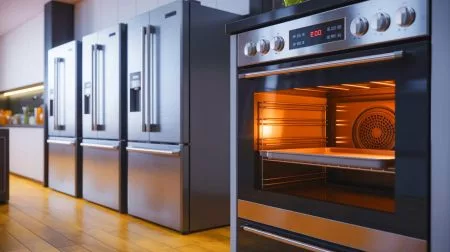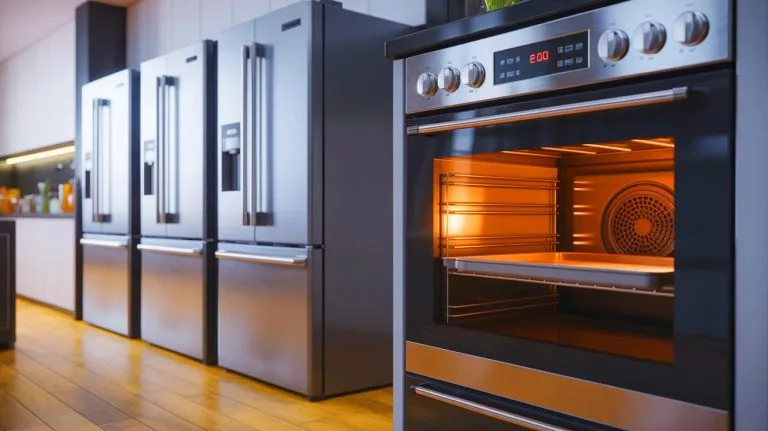| IN A NUTSHELL |
|
In many American households, the electric oven stands as a cornerstone of daily cooking, yet its energy consumption often goes unnoticed. While refrigerators and dryers are commonly recognized for their energy demands, few realize that their ovens may consume even more. An electric oven can draw between 2,000 and 5,000 watts, leading to an average usage of 40 to 90 kilowatt-hours per month. This consumption can be likened to the simultaneous operation of 65 refrigerators. Understanding this can help consumers manage their energy use more effectively and potentially reduce their utility bills.
The Hidden Energy Appetite of Electric Ovens
Electric ovens are a staple in homes across the United States, yet many users are unaware of their substantial energy consumption. Unlike refrigerators, which are known for their significant impact on energy bills, ovens often fly under the radar. The average electric oven operates at a power level between 2,000 and 5,000 watts. This translates to a monthly energy usage of approximately 40 to 90 kilowatt-hours, depending on cooking frequency and duration.
In comparison, refrigerators typically run on 300 to 800 watts, which is significantly lower. This disparity arises because ovens need to generate and maintain high temperatures, while refrigerators focus on maintaining a stable cold environment. Consequently, when an oven is in use, its energy consumption can spike dramatically, equating to the power usage of dozens of refrigerators.
An electric oven can consume as much energy as 65 refrigerators operating simultaneously.
Comparative Energy Consumption: Ovens Versus Other Appliances
A study conducted in 100 French households revealed that electric ovens could reach an annual consumption of 224 kilowatt-hours. This figure far exceeds the energy use of other household appliances, such as refrigerators, which rarely achieve such high levels. The energy usage of ovens is influenced by several factors, including size, model, and duration of use. Naturally, the higher the power and longer the operation, the greater the energy consumption.
It’s important to note that even when turned off, some ovens continue to draw power. Many models remain in standby mode, keeping clocks or digital panels illuminated. A study in California homes found that this standby consumption could average 67 watts per household, accounting for 5% to 26% of the annual energy usage. This phantom energy draw highlights the importance of being mindful of unplugging appliances when not in use.
Strategies for Reducing Oven Energy Consumption
Despite their high energy demands, there are practical strategies for using ovens efficiently without incurring excessive costs. One effective approach is optimizing cooking cycles by using a single preheat to cook multiple dishes. This method not only saves energy but also reduces cooking time. Additionally, turning off the oven a few minutes before the cooking time ends allows the residual heat to complete the process, further conserving energy.
Avoiding frequent door openings during cooking is another important tip, as every opening allows heat to escape, prompting the oven to expend more energy to regain the set temperature. Finally, unplugging the oven after use, particularly if it remains in standby mode, can prevent unnecessary energy leaks. Implementing these small changes can lead to significant energy savings over time.
Understanding the Broader Implications of Energy Use
Recognizing the energy demands of electric ovens prompts a broader discussion on household energy efficiency. As energy costs continue to rise, consumers are increasingly interested in finding ways to minimize their utility bills while maintaining their lifestyle. By addressing the unnoticed energy consumption of everyday appliances, individuals can make informed decisions that benefit both their wallets and the environment.
Reducing energy consumption not only lowers costs but also contributes to reducing the carbon footprint. As more households become aware of these issues, there is a growing opportunity to adopt more sustainable practices. The integration of energy-efficient appliances and the adoption of energy-saving habits are crucial steps in this direction.
The awareness of the significant energy consumption of electric ovens is a call to action for consumers to make more energy-conscious decisions. As technology evolves, there are more opportunities than ever to optimize energy use in the home. Will consumers take these insights and transform them into lasting changes in their energy habits?
Did you like it? 4.5/5 (20)







Is this a joke? 😂 How can an oven consume like 65 refrigerators? Sounds like April Fool’s!
Wow, 65 refrigerators? That’s wild! 😲
I had no idea ovens used so much energy. Time to rethink my cooking habits! 😅
Is this study peer-reviewed? I find it hard to believe.
This seems exaggerated. Can anyone verify this with their own energy usage data?
Thanks for the eye-opener! Time to rethink my cooking habits.